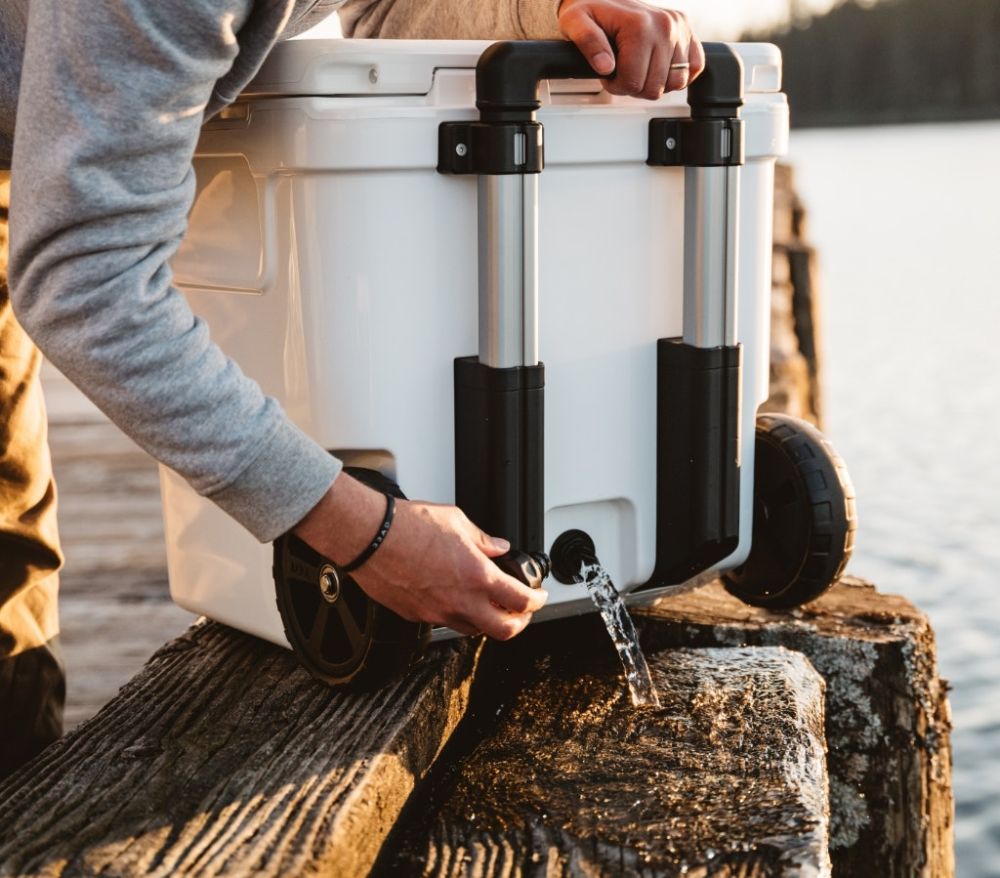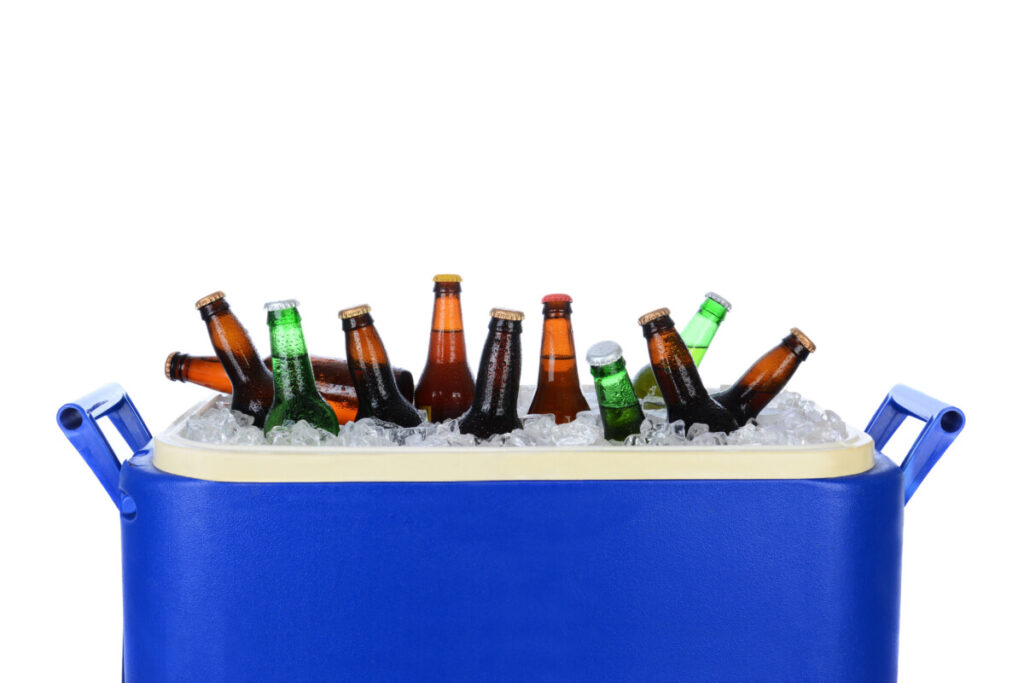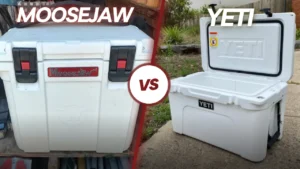When preparing for a picnic, sports event, or any other kind of outing, you fill your cooler with ice. Within a couple of hours, the ice has begun to melt, filling the chest with water. But will draining the water keep the drinks colder?
Draining the water from your cooler keeps the ice longer than not draining it. This is because water (even cold water) is 23.5 times more efficient at transferring heat than air. However, if you have a lot of drinks to keep cold keep the water in can give you more coverage and keep things colder.
Ultimately it's a bit of a trade off. Yes draining your water will mean that the ice you have lasts a little bit longer. However, you'll have less ice overall which will mean the items in your cooler won't stay quite as cold as if you leave the water in.
The answer to this question can depend on several factors, such as the contents of the cooler, the duration of use, and plans to move the cooler. In this post, you will learn about when to drain the water from your cooler as well as how to make ice last longer.
When to Drain the Water from a Cooler

Since the point of using a cooler is to keep food cold, you want to maintain the lowest temperature possible inside the chest for as long as possible. This is especially important if you're transporting foods that need to remain below or near freezing. This may include raw meat or ice cream.
Water takes longer to heat up than air does. So ifyou drain the water from your cooler, there will be more air than ice.
This air will begin to rapidly heat up and because there isn't much ice left the items in your cooler will also be warmed up by this air.
However, if you keep the water in your cooler then you items will be surrounded by cold water, not warm air. This means the contents in the cooler will remain colder for longer. That is up until the ice is fully melted and the water begins to warm up.
Want proof? Coolers on Sale tested whether keeping the water or draining the water from their cooler would get the job done. Draining the water kept more ice in the cooler for longer. However, keeping the water in the cooler maintained a lower temperature for longer. Using this logic, you'll want to keep the water inside your cooler.
Watch the results of the test in the following video.
In this video he used Lifetime Coolers which are one of the best and most affordable coolers on the market. If you're looking for a good cooler that doesn't break the bank this can be a good option.
Click here to read my Lifetime cooler review or alternatively check out my comparison of Yeti and Lifetime coolers or my comparison of Ozark Trail (Walmart) and Lifetime coolers to see how Lifetime coolers stack up to the competition.
When Is It Better To Drain The Water From Your Cooler?

While keeping the water in your cooler will keep it colder for longer, there are certain circumstances in which it's a better idea to drain it.
First and foremost, if you are transporting food in the cooler and you don't want the food to get waterlogged. To prevent this from happening, all the food needs to be stored in water-tight containers or the water needs to be drained as it melts. Click here to learn how to stop food and other items from getting wet and soggy in your cooler.
Another situation where you'll need to drain the water from your cooler is if it becomes contaminated. Say you're transporting raw burger meat for a barbecue later in the package it came in at the grocery store. If the water touches the uncooked meat, it could spread bacteria to all of the other food and drinks in the cooler. Drain the water before it and all the other contents of the cooler become contaminated.
When Is It Better To Keep The Water In Your Cooler?

If you're transporting food that needs to remain below or near freezing (ie. raw meat or ice cream), draining the water will lead to a temperature increase. In these cases it's usually best to keep the water in your cooler. But if you choose to drain the water, you'll need to add more ice otherwise your food and drink will warm up and can go off.
At many events, the cooler will sit in the same place for the entire day. If so, moving it does not need to be considered. However, if you need to move the cooler at any point throughout the day, it may be best to drain the water.
Carrying a cooler full of food and ice is difficult enough. Add the increased water weight and the movement of the water, and suddenly carrying the cooler comes darn near impossible. I've tried to do this many times over the have the water splash out of the lid and all over me.
Drain the cooler before moving it and refill it with ice if possible.
If you have access to ice, always drain the water from the cooler and refill it with ice. This will provide the coldest temperature inside the cooler and prevent food from getting soggy. This is because iced water will always be exactly 0ºC/32ºF (learn exactly why this is and how salt can make ice colder) but ice without water can actually be below 0ºC/32ºF.
You can actually store ice cream inside a cooler if you do it properly, but you need to always drain the water if you're trying to store ice cream.
When you're done using your cooler, drain all the water from it. Flip the cooler over or wipe it out with a towel until dry. Never leave water inside your cooler, as this will lead to mold, mildew, and bacteria growing inside of it.
How to Make Ice Last Longer in a Cooler

In very few places will there be unlimited access to ice. Without access to extra ice, you'll need to find a way to make the ice you have last longer. I've done a full article on how to keep ice longer in a cooler but below are some simple tips.
First, use larger pieces of ice. While ice cubes spread out and cover more of the food, they melt faster than larger ice chunks would. If possible, place larger ice blocks in the bottom of the cooler, fill the cooler with the food, and top off any extra space with ice cubes. Your food is guaranteed to stay cold with this setup.
Another solution to make the ice in your cooler last longer is to add extra insulation to the cooler. If you're camping, try burying the cooler slightly below ground. Remember, however, that this is not a proper way to keep animals such as bears out of your food. If you can't bury the cooler, wrap it in a blanket or surround it with other insulating materials. Here are 10 ways to insulate a cooler so it holds ice longer.
If you have time, try making some super cold ice cubes of your own. Fill ice trays with saltwater and freeze them. When it is time for your trip, fill the cooler with these saltwater cubes. Adding salt to the ice cubes lowers their freezing point. In other words, saltwater ice cubes are colder than plain water ice cubes. You can also add a little salt to any store-bought ice placed in the cooler. But not too much! Too much salt and the ice will begin to melt faster.
The final thing you can do to ensure that the ice in your cooler lasts longer is to put the cooler in a cool location. If you place the cooler out in the open, sunlight will warm the exterior temperature, therefore increasing the internal temperature of the cooler. Find a shaded area for your cooler.



